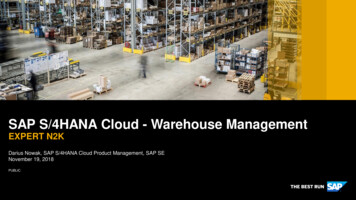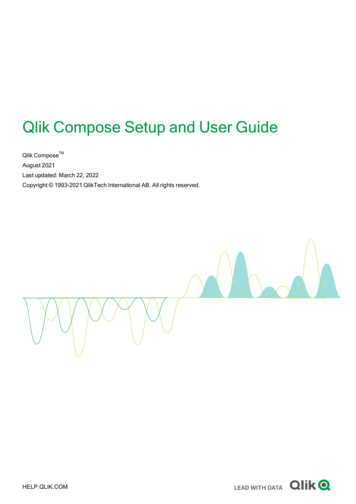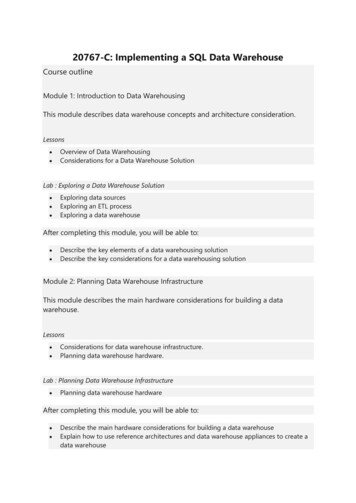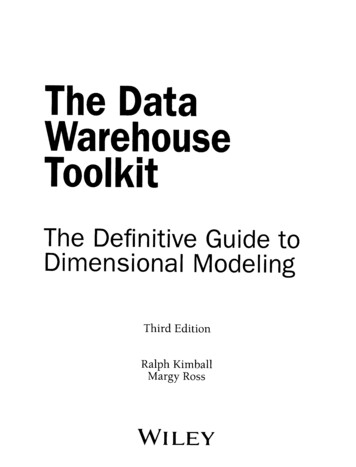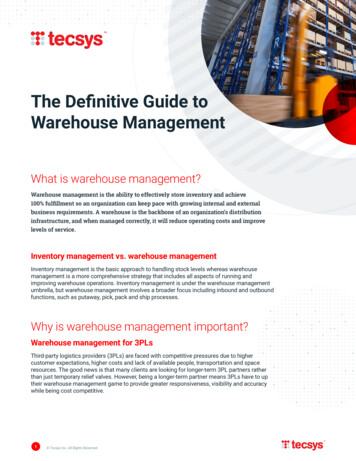
Transcription
The Definitive Guide toWarehouse ManagementWhat is warehouse management?Warehouse management is the ability to effectively store inventory and achieve100% fulfillment so an organization can keep pace with growing internal and externalbusiness requirements. A warehouse is the backbone of an organization’s distributioninfrastructure, and when managed correctly, it will reduce operating costs and improvelevels of service.Inventory management vs. warehouse managementInventory management is the basic approach to handling stock levels whereas warehousemanagement is a more comprehensive strategy that includes all aspects of running andimproving warehouse operations. Inventory management is under the warehouse managementumbrella, but warehouse management involves a broader focus including inbound and outboundfunctions, such as putaway, pick, pack and ship processes.Why is warehouse management important?Warehouse management for 3PLsThird-party logistics providers (3PLs) are faced with competitive pressures due to highercustomer expectations, higher costs and lack of available people, transportation and spaceresources. The good news is that many clients are looking for longer-term 3PL partners ratherthan just temporary relief valves. However, being a longer-term partner means 3PLs have to uptheir warehouse management game to provide greater responsiveness, visibility and accuracywhile being cost competitive.1 Tecsys Inc. All Rights Reserved.
Warehouse management for e-commerceE-commerce growth is pushing companies that were B2B entities into B2C markets and distribution. Now, ratherthan shipping and tracking 1,000 static orders each day, a distributor may have anywhere from 1,000 to 20,000orders daily, from consumers who expect to receive their products within a 24-hour window. This shift representsa real opportunity, but also an innate warehouse management challenge as the B2B distribution model focuses onbulk shipments of pallets and cases while the B2C model focuses on shipping individual products.Top 10 warehouse management best practices1. Eliminate as many touchpoints and non-value adding operations.2. Keep only one system of record.3. Consolidate SKUs as much as possible and manage products from different vendors with aliases.4. Involve vendors in operational processes.5. Automate the input of data everywhere.6. Get product ABC classification and slotting right.7. Streamline picking procedures.8. Stay on top of warehouse metrics.9. Adhere to safety procedures.10. Continuously strive to improve.Benefits of warehouse managementSupply chains are often invisible to consumers, but those in charge of warehouse management know the criticalrole these large buildings used for storage play in everyday life. Good warehouse management provides visibility ofinventory and activity in real time as it moves through the warehouse processes and enables data-driven decisions.Additionally, the space utilization in the warehouse not only ensures the best use of the storage volume, but it makespicking and packing process workflows easier for efficient and rapid order fulfillment. Ultimately, this leads tosavings in labor and costs. When managed correctly, an organization can make quick and accurate decisions, attainflawless execution, deliver excellent customer service, and stay ahead of the competition.2 Tecsys Inc. All Rights Reserved.
Principles of warehouse managementUnderstand the key goals of the warehouseYour warehouse needs to match your business and the first principle is to ensure the management goals within thewarehouse match the goals defined by your organization. Things to consider are: What are your key business objectives? Who are your key customers? What are the most important goods you supply? Is the warehouse as efficient as it can be?Manage your inventory levelsInventory levels cost money and use up space; the warehouse manager needs to balance having the least inventorypossible, but always having what is required by the customer. This process of managing the right inventory levels,and at the same time making sure it is in the right place within the warehouse, is the second principle and requiresaccurate forecasts and effective plans for resolving problems.Control the movement of goodsThe layout of the facility and the location of the goods within the facility all help in controlling the movement ofgoods within the warehouse. This principle is really the process of traveling the least distance possible to performthe most work possible.Make quality a key targetEfficiency and optimization are only valuable if the work is accurate and quality has to be the first and foremost goalof the workers in the warehouse. Creating workflows that drive quality and self-correcting processes throughout thefacility ensure the quality of work within the warehouse.Pick the right WMS software and partnerYour warehouse management system (WMS) will either help or hinder your drive to the previous principles. Gettingthe right technology and right technology partner to run your warehouse will make things far more simple andattainable.How to gain efficiency in the warehouse?The critical factor with gaining warehouse efficiency is understanding both the usage and availability of your space.Getting a handle on the size of your warehouse and the sizes of all your products will allow you to drive efficiency. Attain accurate cube data on all your items and units of measure. Get accurate cube data on all the locations in your warehouse — this does not mean the dimensions, but theactual usable space of each location. Ensure your putaway process allows for flexible inventory placement. Consider the cube of the items when performing ABC slotting. Manage your cross docking and order staging with an eye to the dimensions of the goods.3 Tecsys Inc. All Rights Reserved.
What is a warehouse management system?A well-designed warehouse management system will optimize the flow of materials through your variouswarehouses, managing the processes that are required to move the goods from inbound receiving, through storageand retrieval, and ultimately to outbound picking of customer orders. The WMS is connected to the enterpriseresource planning system (ERP) or order management system (OMS) to receive customer and purchase orderswhich are used as a checklist of goods expected to arrive into the warehouse or pulled from the warehouse.What does a warehouse management system do?At its simplest level, a warehouse management system utilizing mobile technology will lead an operator through theprocess of moving goods from place to place within the warehouse. The technology behind the WMS will attempt todo this in the most effective and efficient way, while making sure the operator makes zero errors during the process.In addition, the WMS will track and record the goods already in the warehouse to make sure they are being stored inthe proper locations and consumed in the correct sequence.Take for example a warehouse that serves a mid-sized distributor of hard goods; throughout the process ofmanaging the warehouse there are decisions that must be made and critical instructions that must be followed. AWMS will track and manage these processes while ensuring 100% accuracy with the least amount of labor.ReceiptThis is the process of when goods arrive at the warehouse shipping dock. A WMS will efficiently help determine andconfirm the right product, in the right quantities, in the right condition, weight and dimensions all at the right time.PutawayThe objective is to move goods received to an optimal storage location as quickly and efficiently as possible. Duringthe putaway process a WMS considers different factors (e.g., if the goods need refrigeration, if there is an orderalready waiting for the goods, etc.) and calculates the location and best possible route to take when putting away theitems.StorageThis is a critical process to ensure all available space in the warehouse is maximized without compromisingproductivity. A WMS tracks if goods are in the best location, if the amount of goods is accurate or if a reorder isnecessary, if the goods have expired, etc.PickingThis is the process used to retrieve goods in the warehouse and consists of picking by item, group or zone. TheWMS communicates and controls the picking task by providing explicit direction to the pick person via mobile datadevices, interactive voice and pick-to-light modules, and by controlling the quality of results with various forms ofautomatic identification (e.g., barcode scanning, etc.). Directions will include details such as how many to pick,what type of pack size is best to pick, which lot number to pick and if the item requires pre-work (e.g., price labeling,tagging, assembly or similar).4 Tecsys Inc. All Rights Reserved.
How does a warehouse management system fit in thesupply chain?A warehouse management system performs three key functions for the supply chain: cross-docking, distribution andwarehousing. Balancing these three warehouse management functions creates an efficient supply chain operationand enables you to adapt to customer demands.Cross-dockingThis is the management of goods in the warehouse that are received and shipped within a very short timeframe.There is usually little to no on-hand inventory and the focus of a cross-docking operation is to eliminate storageand retrieval tasks. This is applicable to the initial receipt of seasonal items, non-stock or pass-through items andbackordered items. The WMS helps ensure the product is received and staged for shipping in as few steps aspossible.DistributionThis is the management of goods that have relatively low inventory levels and a high turn rate. The focus of adistribution center operation is satisfying customer orders as efficiently as possible while holding the least inventory.The WMS simplifies the order picker’s job by using appropriately sized and identified picking locations. Overstock isusually kept near pick locations and there is an emphasis on the optimum slotting of items.WarehousingThis is controlling stock items with high inventory levels and a low turn rate. The focus of a warehouse operation isto maximize storage capacity and typically has a low SKU count, but high inventory levels. The WMS orchestratesthe product (e.g., imported items, emergency use items, production operation goods, etc.) from receipt to storage inhigh-capacity locations.Types of warehouse management systemsWarehouse management systems can be divided into three types: the standalone warehouse system, the ERPmodule and the best-of-breed warehouse management system.Standalone warehouse management systemThis WMS is often referred to as an inventory control system. While simple to implement and low cost, it offers theleast amount of functionality and value.ERP moduleWith similar functionality to a standalone WMS, this type of WMS is built as a piece of a much larger ERP system.Hence, the solution provider typically places less investment on the WMS capability, so this type is not ideal forcomplex warehouse operations.Best-of-breed warehouse management systemThis type of WMS is often split into cloud and on-premise implementations and can range from simple and targetedto huge, broad and mature warehouse solutions. A supply chain warehouse execution system is usually integratedinto an ERP and OMS. It offers best-of-breed warehouse features for organizations that have outgrown thestandalone WMS and ERP module solutions.5 Tecsys Inc. All Rights Reserved.
Succeeding in a challenging distribution environmentSimply put, it is not always easy to achieve highly effective distribution operations in today’s fast-paced environment.Customer expectations are exceptionally high in the era of the “Amazon effect,” when fulfillment cycles and deliverytimes must be continually compressed. This is because consumer expectations for expedited delivery have becomethe norm on the B2B side as well, placing untold pressures on global supply chains.Exceptional warehouse management is the key to growth and long-term success. This is possible through the rightapproach to technology, which includes any necessary material handling equipment as well as a proven, feature-richwarehouse management system. Only with effective systems underpinning your operations can you process thegrowing volumes of orders, manage inventory and ensure your associates carry out each step of their directed tasksproperly every minute of the day. Accuracy and reliability are essential. There isn’t any room for error if you want tostay competitive.In today’s warehouse operations, we see more business volumes, more goods to move to multiplechannels, under tighter cycle times. Combined with labor shortages and stringent regulatoryrequirements, the pressure on executives is greater than ever! As a result, they have no alternative butto make a technology change to a robust and flexible WMS to keep up with their changing businessrequirements. Given their business conditions, they need to do it at low-risk and low-cost, in other words,get top WMS value at a low total cost of ownership. – Michael Mikitka, CEO of WERC (WarehousingEducation Research Council)Why are companies upgrading their warehousemanagement systems?You may hear about warehouse management system upgrade projects and wonder when the right time is to moveyour existing WMS to the latest version. If you are running a traditional system, the time may be right for you toexplore the more modern options now available for your operations.Below are some common reasons a business will upgrade. These are often determined by developing a businesscase that fully explores all aspects of the business and future expectations from customers. The cost of staying on the current system is higher than it would be to move to a new system. The current system is now restrictive and cannot support organizational growth. The current system is not effectively serving existing customers or helping to win new business. The investment in a new system will support innovation and the opportunity to be more competitive in themarketplace.The pivotal role of the warehouse management systemThe WMS plays a crucial role in enabling your organization to complete daily activities spanning from receiving,putaway and inventory management to picking, packing and shipping — and much more. Anything less than a robustWMS will hinder your ability to grow and serve customers effectively.6 Tecsys Inc. All Rights Reserved.
Unfortunately, many decision makers delay the move to a best-of-breed warehouse management system becauseof the perceived disruption these projects can cause. A feature-rich WMS can certainly involve an extensive amountof work to develop processes, configure the software, integrate with your enterprise systems, prepare the ITinfrastructure and execute testing plans. However, delaying the move to the right technology in turn can postponeresponding to customers’ needs, revenue-generating growth and the competitiveness of your business in the market.Some companies have elected to implement “WMS light” options designed with a reduced feature set. However,these typically do not allow for the type of growth and the associated complexity in distribution requirements thesecompanies may ultimately require.3 reasons to leverage a warehouse management systemGiven the complexities of the supply chain today, there are several important elements to consider when selectingthe right technology for your business. Zeroing in on the right warehouse management system is a career-definingdecision. You must take a thorough approach in your decision-making process by evaluating your challenges,requirements, budgetary constraints, expectations and the range of options available.1.FunctionalityIt is essential to have a warehouse that is scalable and easily adaptable to your specific needs, market conditions orunique customer requests. A top-notch WMS will have core warehouse features that go beyond the standard optionssuch as receiving, putaway, counting, letdown and picking. While these remain important capabilities, you needfunctionality that enables you to meet industry-specific requirements such as value-added services; full lot, serial andexpiration track/trace and many more that will enter the picture as appropriate.2.User experienceLabor is a critical element to a warehouse and it is important to provide workers with highly intuitive technology tohelp them be as efficient as possible – right out of the gate. The WMS should be easily understood with step-by-stepinstructions and visual cues to ensure accuracy and compliance. Particularly if temporary or seasonal workers areimportant for your business, technology that is easy to adopt with minimal training will be the key to success.3.FlexibilityThe way your warehouse operates today might not be the same way it needs to operate in the next few years. Manycompanies are making increasing use of cloud deployments to ensure the flexibility of their supply chain. A WMScan scale and adapt automatically with elastic technologies and tools that are secure and continuously upgraded tomeet the needs of your industry and business.Features of warehouse management systemsInventory trackingIdentifies where all inventory is located and individual key characteristics about that inventory such as lot number,expiration date, etc.Receiving and putawayAccepts goods into the warehouse and determines the optimum place to store them based upon usage, need, cube,space available, etc.7 Tecsys Inc. All Rights Reserved.
Picking and packingFulfills customer orders in the most efficient and accurate way possible. There are many techniques used to reducetime and travel during the picking phase and usually a combination based upon the nature of the orders is mosteffective.ShippingManages common carrier and own fleet shipping with an embedded transportation management system (TMS) thatallows warehouse planning decisions and efficient picking and packing operations.Yard and dock managementTracks and controls where goods are in the yard and schedules dock appointments for both inbound and outbounddeliveries.Reporting and analyticsOffers key metrics with generated reports and dashboards to help measure warehouse performance and makeinformed, strategic operational decisions for efficiency and resource use.Ways a modern warehouse management system helpsreduce costsAutomates manual processesFrom receiving, putaway and inventory management to picking, packing and shipping, there are many ways you canleverage automation to forego routine, manual processes. Assess your operations and determine where the lowhanging fruit resides when it comes to what to automate first. A good place to start are the repeatable and timeintensive activities, especially those prone to error. Do not forget to evaluate material handling equipment (MHE)that can integrate with your warehouse management system to speed operations. Conveyors, pick-to-light systems,automatic guided vehicles (AGVs), automated storage and retrieval systems (AS/RS) and more not only help yourworkers complete assignments faster, but they can also improve safety and take the physical burden out of some ofthe steps.Enhances workforce efficiencyFinding and retaining a solid workforce is a growing challenge for many companies. A warehouse managementsystem that is easy to work with and simplifies the process of completing tasks accurately will make a world ofdifference in your ability to hire, train and retain staff. If you are able to introduce automation as mentioned above,you may find you can carry out the same tasks with fewer associates. However, this does not necessarily mean youhave to let workers go. It is feasible to offer additional training to some associates and redeploy them to other areaswhere performance may be an issue. You can also use newfound employee bandwidth to implement offerings suchas personalized, value-added services that delight your customers.Optimizes inventory managementHaving too much inventory, not having enough or lacking the right kind of inventory all create financial stress andcustomer service challenges for your organization. The first requirement to improving inventory management andlowering your holding costs is having visibility into what is on the shelves and the rate at which it is depleted andreplenished. This is possible with a warehouse management system in concert with an inventory managementsystem that tracks the ins and outs as well as prompts cycle counting and reconciliation. The ability to forecastdemand is also an important step as you work to implement an optimum level of inventory to carry and lowerinventory holding costs over time.8 Tecsys Inc. All Rights Reserved.
Enables best practice implementationAlthough supply chain experts have been developing best practices for decades, recent changes in distributionmodels, technology and customer expectations have led to new insights into the best ways to run distributionoperations. A warehouse management system provider has a deep understanding of supply chain best practicesand can introduce efficiency into your distribution operation. Learn the latest best practices regarding facility layout,how to leverage technology and manage your workforce in pursuit of meeting customer requirements and keepingcosts in check.Measures performanceBest-in-class distribution operations of any size rely on accurate metrics and analytics for informed decision-making.From labor productivity to fulfillment speed and shipping accuracy, intuitive WMS dashboards will help you get ahandle on which areas are not running efficiently, where cost spikes point to underlying issues and more. Whatyou seek is information that can help you take action, enabling ongoing improvement and cost reduction acrossmany areas. This may include dropping a product line that is not performing well, reallocating staff to addressperformance issues or identifying expiring products and waste.How to choose the right warehouse management systemA modern warehouse management system will support your business as it grows and changes into the future.You will want to find a system that offers low overall risk. This means you can get up and running quickly on thesystem via a rapid implementation model and can make software changes over time to meet new challenges. Thisadaptability is a critical factor in molding the system to your specific customer or industry requirements whereappropriate.Finding a system that is ‘future proof’ is also important. Not only do you need core functionality to be in place today,but you also need to be able to stay on the upgrade path down the road as new enhancements are released and youwant your warehouse management system to keep pace.Traditional WMS vs. modern WMSHardwareTraditional: Large ‘brick on a stick’ mobile terminals with physical buttons.Modern: Familiar smartphone or tablet devices running Android or iOS.AdoptionTraditional: Long and complex implementations, formal training sessions run by the vendor.Modern: Low risk and rapid to adopt, uses familiar technology which improves user experiences with user-driventraining and configuration.FlexibilityTraditional: Any changes to the standard process require custom coding that makes upgrades expensive anddifficult.Modern: Features and workflows can be adapted using scripts, configurations and workflow management tools bysuper users who are semi-technical and do not require developers.9 Tecsys Inc. All Rights Reserved.
ScalabilityTraditional: Limited by the hardware and network locally available, once set is generally fixed.Modern: Totally elastic solution for any size implementation; can flex along with seasonality requirementsthroughout the year as needed.FeaturesTraditional: Feature set is basic receive, putaway, letdown, count and pick.Modern: Industry or process-specific features that are configurable by the role of the user.PlatformTraditional: There isn’t one.Modern: The supply chain platform creates a common, stable and personalized environment that allows user-centricchange to the look and feel of the system without affecting the underlying solution. It also provides an integrationlayer to simply and rapidly connect.What are the benefits of a cloud warehouse managementsystem?SecurityCloud environments are tested and audited to the highest standards ensuring your data is 100% secure.ReliabilityCloud solutions have service standards and constant monitoring tools to ensure your system is available all the time.PerformanceGenerally backed by very large, international infrastructures, cloud solutions can ensure a minimum level ofperformance for your warehouse system.ScalabilityMost cloud warehouse management systems offer automatic scaling of the cloud environment to balance load andoffer you more or less technology hardware as your demand rises and falls.ComplianceUnlike in-house IT groups, cloud infrastructure is dedicated to ensuring it is compliant with any and all industryspecific or regulatory requirements.RecoveryWith cross-regional and constantly monitored disaster recovery features, cloud warehouse management systemsensure that data is never lost.10 Tecsys Inc. All Rights Reserved.
7 key steps to implementing warehouse managementsystemsStep 1: IdentifyThe most important part of any project is to figure out what are the key problems you need to solve and whichtechnology partner has the most relevant experience that fits your company culture best.Step 2: Initiate and PlanIntroduce and explain the nuances of your operation to your technology partner and plan the end-to-end project —understand both the staffing and timeline.Step 3: Analyze and DesignDefine with your partner how your new system will work, making sure all the key processes and integration steps arewell documented and understood. Start to collect and cleanse the master data needed to run the system.Step 4: Build the SolutionCreate the solution configuration, load the master databases, build the integration, train the internal subject-matterexperts and create the test plans.Step 5: ValidateCheck everything and test how your system will operate. Closely examine the integration, stress test the system andtrain the users by doing some dry runs. Finally, decide if you are ready to go-live!Step 6: DeployWhen you are ready to go-live, transition to the new system and possibly do an inventory count. And do not forget tosupport the users through the learning phase.Step 7: ReviewComplete a retrospective review post-implementation and create optimization plans to support your continuousimprovement processes.Future of warehouse managementWarehouse management is at a nexus point where the industry is moving away from gradual evolutionary steps thatimprove the warehouse management processes to truly revolutionary change in the warehouse and the technologythat runs it. The changes are brought on by the increase in complexity and volume of transactions in the warehouseover the last few years — and that rate of change is only accelerating. This, along with the shortage and increasingcost of labor, has meant that automation and AI techniques are increasingly being applied to the traditionalwarehouse management system.Automation in the form of collaborative robots all the way to complex automated storage and retrieval systemslike AutoStore are being adopted to address these transaction, volume and labor issues. In addition, warehousemanagement systems are getting smarter and applying machine learning technology to do the tasks needed tomake the warehouse floor the most efficient. Jobs like cluster building, task management and pick allocation are allbeing managed in real time, revised dynamically by AI in ways that will build efficiency and change the warehousefloor operation forever.11 Tecsys Inc. All Rights Reserved.
Elite warehouse management systemTecsys’ Elite WMS is a visionary, scalable and adaptable solution that addresses the complexity and economicchallenges of distribution operations in several industries to help you keep pace with a shifting landscape and moveforward confidently.Your warehouse operation is your most vital asset to deliver on promises made to customers and achieve a highlevel of customer satisfaction. In today’s world, a combination of best practices and platform technology helpsworld-class distribution organizations achieve market differentiation, eliminate inefficiencies, improve orderaccuracy, reduce operating costs and attain high levels of service. Undoubtedly, your warehouse is more critical thanever.For more than three decades we have helped hundreds of leading organizations solve their unique warehousingand distribution challenges — landing us in the “Visionaries” quadrant of Gartner’s Magic Quadrant* for warehousemanagement systems for the last ten consecutive reports. Since our founding, we have been lauded by a stream ofrenowned organizations that have adopted our solutions.Canon, Cleveland Brothers, DB Schenker, Delmar International, Humana, Intermountain Healthcare, MiltonCAT, Napoleon Products, Parkview Health, Rinchem, Robinson Home Products, Walter Surface Technologies,Werner Electric Supply and many others.Advanced core warehouse management functionalityElite WMS provides advanced functionality for receiving, putaway, inventory moves, picking, packing, replenishment,shipping, loading and cycle counting. This helps ensure that all your warehouse operational requirements are met.System-directed RF task management and taskinterleavingWith system-directed RF task management and task interleaving, the Elite WMS removes the complexity andinefficiency of your material handlers picking their next task or being assigned to only perform a single task in thewarehouse. Customers have increased efficiency and accuracy by double digits at the lowest possible operatingcost.Multiple
A warehouse management system performs three key functions for the supply chain: cross-docking, distribution and warehousing. Balancing these three warehouse management functions creates an efficient supply chain operation and enables you to adapt to customer demands. Cross-docking



